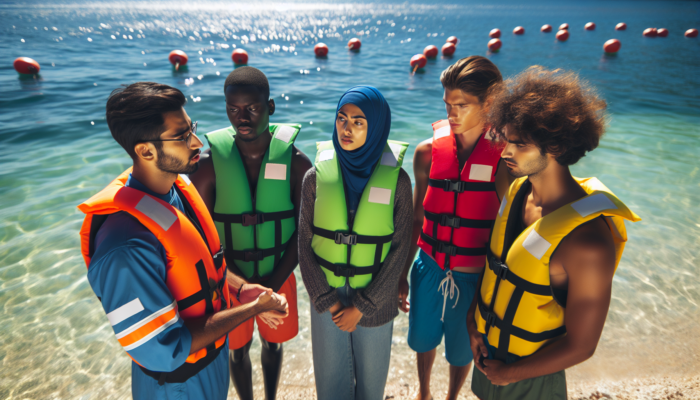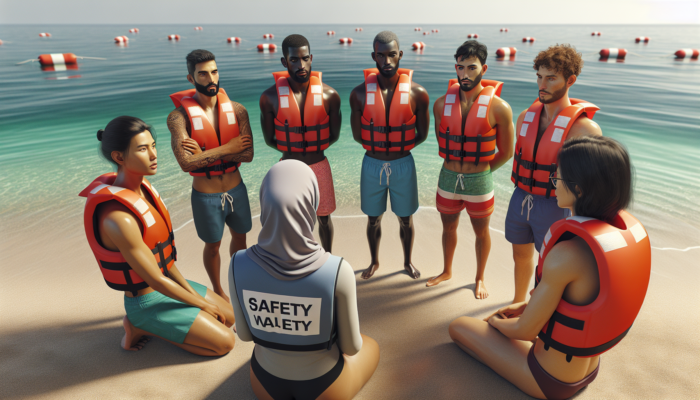Comprehensive Evaluation of Water-Related Risks for Safer Recreational Activities

Engaging in water-related activities not only brings immense enjoyment and relaxation but also requires a thorough understanding of the substantial risks that accompany these experiences. By recognizing and understanding the potential dangers that can arise in various aquatic environments, ranging from swimming pools to vast open waters, individuals can enjoy safer swimming experiences. This knowledge empowers enthusiasts to adopt proactive measures to mitigate risks, ultimately fostering a more enjoyable and secure setting for everyone involved in aquatic pursuits.
Identifying and Understanding Common Water Hazards to Boost Safety Awareness
The dangers associated with different water environments are numerous and can vary greatly based on the specific setting. In swimming pools, common hazards include slips and falls, diving injuries, and other incidents that can result in serious accidents. Furthermore, chemicals</b present in pool water can pose additional risks; improper handling of these substances may lead to chemical burns or respiratory issues. In contrast, open water locations introduce unique challenges such as strong currents, unpredictable tides, and the presence of potentially dangerous aquatic life, all of which can create hazardous situations for swimmers.
To effectively prepare for safe swimming, individuals must focus on educating themselves about the specific characteristics of the aquatic environment they intend to enjoy. For example, understanding that lakes and rivers may conceal hazardous rocks, sudden depth changes, or submerged debris is crucial for ensuring safety. This awareness allows swimmers to exercise caution and make informed decisions, significantly reducing the likelihood of accidents during their aquatic adventures.
Another critical aspect of water safety involves understanding environmental conditions. Variations in weather and water temperature can profoundly influence overall safety. Cold water can incapacitate even the most proficient swimmers, while storms and high winds can create perilous conditions. Being cognizant of these factors equips individuals to accurately assess risks and select the most suitable times and locations for engaging in swimming activities.
Executing a Detailed Risk Assessment for Safer Swimming Experiences
Evaluating the safety of a swimming area necessitates a careful assessment of several factors, such as water depth, current strength, and visibility. A comprehensive understanding of these elements can significantly enhance overall safety. For instance, when swimming in the ocean, it is essential to analyze wave intensity and current conditions, as powerful undertows can pose severe threats, even for experienced swimmers.
Water depth is a primary consideration in this assessment. Shallow areas can lead to injuries from diving or jumping, while deeper waters might conceal hazards like sudden drops or unpredictable currents. Visibility is equally vital; murky or unclear waters can obscure dangers and make it challenging to locate swimmers in distress, thereby heightening the risk of accidents and emergencies.
Before entering any body of water, individuals are strongly encouraged to conduct a personal risk assessment. This includes identifying designated swimming areas and paying close attention to warning signs. Understanding local water conditions, including temperature fluctuations, tide schedules, and advisories from local authorities, is crucial for ensuring a safe swimming experience.
Implementing Proven Strategies for Preventing Water-Related Accidents

Preventing accidents in aquatic environments is of paramount importance and can be achieved through various strategies. One of the most effective measures is ensuring that lifeguards are present in public swimming areas. These trained professionals are equipped to respond swiftly to emergencies, making their presence invaluable in reducing the risk of drowning and other incidents that could lead to serious injury or loss of life.
Safety barriers form another vital component of water safety practices. Fencing around swimming pools, for example, can prevent unsupervised access, particularly for young children who are at a greater risk. Additionally, clear warning signs and easily accessible flotation devices can augment safety in open water areas, alerting swimmers to potential hazards and providing essential tools for self-rescue during emergencies.
Alongside physical barriers, educating swimmers about safe practices is crucial for promoting water safety awareness. Informing individuals about the significance of swimming with a buddy, understanding personal limitations, and recognizing potentially hazardous conditions can significantly improve safety outcomes. Establishing a culture of accountability among swimmers ensures that everyone prioritizes safety, making water activities enjoyable and secure for all participants.
Developing Critical Swimming Skills and Techniques to Improve Safety
Acquiring essential swimming skills is not only beneficial for enjoyment but also serves as a fundamental aspect of ensuring personal safety in aquatic environments. A comprehensive set of swimming techniques enables individuals to effectively manage various situations, boosting their confidence and enhancing their enjoyment of water-related activities.
Mastering Essential Swimming Strokes for Enhanced Efficiency and Safety
Mastering foundational swimming strokes, such as freestyle and breaststroke, is vital for effective movement through water. Freestyle, celebrated for its speed and efficiency, allows swimmers to cover distances quickly while maintaining control. Regular practice of this stroke not only enhances cardiovascular endurance but also strengthens upper body muscles, contributing significantly to overall fitness and proficiency in the water.
Conversely, breaststroke is a crucial technique that emphasizes breath control and timing. This stroke is particularly advantageous for beginners, as it accommodates a comfortable pace and fosters a sense of security in the water. Grasping the mechanics of both strokes aids swimmers in developing their skills and adapting to diverse swimming environments, whether in pools or open water.
Learning these fundamental strokes also cultivates confidence, encouraging swimmers to explore more challenging environments. With consistent practice and dedication, individuals can enhance their proficiency, ensuring they are well-prepared for emergencies and capable of enjoying a wide range of aquatic activities safely.
Acquiring Essential Survival Swimming Techniques for Enhanced Safety

Mastering essential survival swimming techniques, such as floating and treading water, is crucial for saving lives in unforeseen circumstances. Proficient floating skills allow individuals to conserve energy while remaining buoyant, providing vital time for rescue or an opportunity to reassess their surroundings and plan their next steps.
Treading water represents another critical survival skill. This technique involves a combination of arm and leg movements that enable a person to remain afloat while expending minimal energy. Regular practice of treading water not only enhances endurance but also prepares individuals for scenarios where they may need to stay afloat for extended periods, whether in open water or during emergencies.
Integrating survival swimming techniques into routine training is advantageous for swimmers of all skill levels. Whether in a pool, lake, or ocean, these essential survival skills promote confidence and contribute to a safer swimming experience for all participants.
Exploring Advanced Swimming Techniques for Competitive Excellence
Advanced techniques, such as flip turns and underwater dolphin kicks, can be incredibly beneficial for those eager to elevate their swimming capabilities. Flip turns facilitate efficient transitions when swimming laps, enhancing speed and minimizing the time spent at the wall during competitive events. Mastering this technique allows swimmers to maintain momentum and improve overall performance.
Underwater dolphin kicks are equally advantageous, particularly in competitive swimming scenarios. This technique involves adopting a streamlined position and employing rhythmic movements that propel swimmers effectively through the water. Regular practice of these advanced techniques can greatly enhance a swimmer's ability to navigate challenging conditions, making them more adaptable to various aquatic environments.
Engaging in advanced training not only sharpens swimming skills but also boosts overall fitness levels, promoting cardiovascular health and muscle strength. As swimmers become more adept, they gain the confidence necessary to tackle different water conditions and participate in a broader range of aquatic activities, enriching their enjoyment and safety.
Building Endurance and Fitness through Targeted Swimming Drills
Developing stamina through targeted swimming drills and exercises is essential for long-distance swimming and overall health. Regular swimming workouts can significantly improve cardiovascular endurance, enabling swimmers to tackle challenging distances with greater ease. Incorporating interval training, where participants alternate between high-intensity sprints and recovery periods, aids in building endurance while simultaneously improving speed and efficiency in the water.
In addition to formal training sessions, integrating fitness exercises both in and out of the water can further enhance swimming performance. Strength training that focuses on core muscles, arms, and legs builds the muscle groups necessary for effective swimming strokes. Improved overall fitness not only contributes to enhanced swimming but also promotes general health and well-being.
Moreover, setting specific fitness goals and tracking progress can motivate swimmers to push their limits. Whether training for a competition or aiming for personal fitness milestones, embracing a comprehensive approach to swimming and fitness encourages a healthier lifestyle and fosters a lifelong passion for water activities.
Essential Safety Equipment and Gear for Swimming
Having the right safety equipment and gear is crucial for ensuring a secure swimming experience. From life jackets to personal safety devices, understanding the various tools available can significantly enhance safety in and around water.
The Vital Importance of Life Jackets in Water Safety
Wearing properly fitted life jackets is essential, particularly in open water or boating situations. Life jackets provide vital buoyancy, acting as a lifeline for individuals who may find themselves in distress. Selecting a life jacket that meets relevant safety standards and is appropriate for the individual’s size and weight is imperative to ensure maximum safety.
Before embarking on any water-related activities, individuals should ensure that all members of their group are equipped with life jackets, especially children and inexperienced swimmers. Properly wearing and adjusting life jackets guarantees optimal safety and functionality. Regular inspections of life jackets for wear and tear ensure they remain reliable and ready for use whenever needed.
Promoting the significance of life jacket usage within the community contributes to a culture of safety. Engaging in awareness campaigns and emphasizing the necessity of life jackets during boating or swimming in open waters establishes a proactive approach to water safety.
Familiarizing Yourself with Rescue Equipment for Emergency Situations
Understanding how to utilize rescue equipment, such as life rings and throw ropes, is fundamental in facilitating emergency water rescues. Life rings are designed for easy throwing to distressed swimmers, providing immediate flotation assistance until help arrives. Knowing how to effectively deploy rescue equipment ensures a more efficient emergency response, potentially saving lives in critical situations.
Throw ropes offer another layer of safety, allowing rescuers to reach individuals in distress without entering the water themselves. Familiarity with the proper handling and throwing techniques for throw ropes can significantly enhance rescue efforts. Practicing these skills in controlled environments prepares individuals for real-life scenarios, ensuring they can act quickly and effectively in emergencies.
Integrating knowledge of rescue equipment into water safety education initiatives fosters a more informed community. Encouraging awareness of available resources enhances collective safety, ensuring that everyone is prepared to act in emergencies when necessary.
Utilizing Personal Safety Devices for Enhanced Comfort and Protection
Additional gear, such as swim goggles and earplugs, can greatly improve both comfort and safety in the water. Swim goggles protect the eyes from irritation caused by chlorine and enhance visibility while swimming. Exploring different types of goggles allows swimmers to find a pair that suits their preferences and improves their overall experience in the water.
Earplugs are equally beneficial, particularly for individuals prone to ear infections or discomfort while swimming. Effective earplugs help prevent water from entering the ears, reducing the risk of conditions such as swimmer's ear. Understanding the various personal safety devices available empowers swimmers to make informed choices that enhance their enjoyment and safety in aquatic environments.
Investing in quality personal safety devices and promoting their use within the community fosters a culture of safety. By prioritizing comfort and protection, swimmers are more likely to engage in water activities regularly, contributing to their overall well-being and enjoyment.
The Critical Role of Safety Whistles as an Essential Emergency Tool
Safety whistles can be invaluable for signaling distress and attracting attention during water emergencies. Carrying a whistle while swimming, especially in open waters, can significantly enhance a swimmer’s chances of being located quickly. In emergencies, the sound of a whistle travels much farther than a person’s voice, making it an essential safety tool.
Understanding how to use safety whistles effectively is crucial. Swimmers should be encouraged to blow the whistle in a series of short bursts, as rescuers are more likely to recognize this pattern. Additionally, familiarizing oneself with safety protocols, such as where and how to call for help, can significantly enhance emergency response times.
Promoting the use of safety whistles within swimming communities encourages better preparedness and awareness. Establishing a culture where swimmers are equipped with essential safety equipment helps create safer aquatic environments for everyone involved.
The Importance of Supervision and Responsibilities in Enhancing Water Safety
Ensuring continuous supervision is fundamental to water safety, particularly for children. The responsibility of adults and caregivers in monitoring water activities cannot be overstated, as their vigilance can prevent many accidents and save lives in critical situations.
The Impact of Adult Supervision on Water Safety and Accident Prevention
Constant adult supervision of children in and around water is vital for preventing accidents. Adults should always remain vigilant and be prepared to respond quickly to any emergencies that may arise. Establishing designated watch areas ensures that caregivers can focus on monitoring children without distractions or interruptions, thereby enhancing overall safety.
Teaching children about water safety and swimming within designated boundaries further strengthens overall safety. Educating them on signals for assistance and encouraging open communication about their comfort levels in the water fosters an environment where children feel secure and supported while enjoying their aquatic experiences.
Moreover, encouraging adults to take swimming lessons can enhance their ability to respond effectively in emergencies. Adult supervision becomes more effective when caregivers possess essential swimming skills and knowledge of water safety practices, ultimately leading to safer aquatic environments for everyone.
Enhancing Safety Through the Buddy System for Swimmers
Implementing the buddy system is a straightforward yet highly effective strategy to improve swimmer safety. By ensuring that swimmers are never alone, the buddy system promotes mutual monitoring and assistance, significantly reducing the risk of accidents occurring in the water.
Encouraging swimmers to pair up reinforces accountability and communication among participants. Buddies can actively watch each other, ensuring that help is readily available if one encounters difficulties. Revisiting the importance of the buddy system during water safety education initiatives can help instill this practice in young swimmers, promoting a culture of safety.
Additionally, incorporating the buddy system into swimming lessons and activities fosters strong bonds among participants, enhancing their overall enjoyment. As they learn the value of teamwork and support, swimmers develop essential skills that carry over into other aspects of their lives, promoting collaboration and safety.
Understanding the Crucial Role of Lifeguards in Aquatic Safety
Grasping the responsibilities of lifeguards is essential for promoting water safety. Lifeguards are trained professionals who play a pivotal role in ensuring the safety of all individuals in aquatic environments. Their presence significantly enhances safety through vigilant monitoring and immediate response to emergencies, making a critical difference in preventing accidents.
Lifeguards undergo extensive training in water rescue techniques, first aid, and CPR. Their ability to assess risks and respond promptly to incidents is invaluable in preventing accidents and saving lives. Encouraging individuals to respect lifeguards’ authority and adhere to their instructions enhances safety for everyone engaged in water activities.
Fostering positive relationships between lifeguards and the community promotes a culture of safety. Engaging with lifeguards and attending water safety workshops can help individuals better understand their roles and the importance of their presence, thereby improving safety practices in local swimming areas.
Effective Emergency Response and First Aid Techniques for Water Incidents
Being prepared for emergencies is critical for ensuring safety in aquatic environments. Understanding how to recognize distress signals and respond effectively can save lives and mitigate the consequences of water-related incidents.
Recognizing Signs of Distress in Water Emergencies
Identifying signs of drowning and other water-related emergencies is vital for prompt and effective response. Contrary to the dramatic portrayals often depicted in media, drowning can occur silently and rapidly. Observing signs such as a swimmer struggling to keep their head above water or exhibiting erratic movements can indicate distress and necessitate immediate action.
In addition to physical signs, being attuned to behavioral changes, such as unusual quietness or signs of panic, is essential for effective intervention. Recognizing these behaviors enables bystanders to act swiftly, whether by calling for help or entering the water to assist, provided they are trained and capable of doing so safely.
Education and awareness initiatives can significantly enhance individuals’ ability to recognize distress signals. Workshops and training sessions can equip swimmers and caregivers with the knowledge necessary to identify emergencies and respond accurately and effectively.
Mastering Safe Rescue Techniques for Water Emergencies
Mastering effective methods for rescuing someone from the water is crucial for minimizing the risk to both the rescuer and the victim. Understanding how to approach a rescue involves assessing the situation and ensuring one's safety before intervening, thereby reducing the chances of further incidents.
One effective rescue technique involves using a reaching assist, where the rescuer offers a stable object, like a pole or a rope, for the distressed person to grab onto. This method allows the rescuer to maintain a safe distance while providing essential support. When entering the water is necessary, trained rescuers should employ safe entry techniques to avoid putting themselves at risk.
Practicing rescue techniques in controlled environments enhances confidence and proficiency among swimmers. Regular training sessions can ensure that individuals are adequately prepared to assist others in emergencies, thereby contributing to a safer community overall.
Essential First Aid Skills for Water-Related Incidents
Knowing fundamental first aid procedures for addressing water-related incidents is crucial for effective intervention. Basic first-aid skills, including CPR and treatment for hypothermia, can significantly impact outcomes in emergencies and potentially save lives.
CPR is a lifesaving technique that involves chest compressions and rescue breaths to restore breathing and circulation in individuals who have stopped breathing. Understanding how to perform CPR correctly and efficiently can provide vital assistance until professional help arrives, making it a critical skill for anyone engaging in water activities.
Hypothermia, a potentially life-threatening condition that can occur in cold water, requires prompt recognition and treatment. Identifying symptoms, including shivering, confusion, and fatigue, is essential for effective intervention. Gradually warming the individual while seeking medical attention can prevent serious complications from arising.
Regular first aid training and certifications are essential for maintaining knowledge and skills in emergency response. Encouraging community members to participate in first aid courses fosters a culture of preparedness, ensuring that more individuals are equipped to respond effectively when emergencies arise.
Effective Communication Strategies During Emergencies
Effective communication with emergency services during water-related incidents ensures rapid response and assistance. Knowing how to convey essential information, including the nature of the emergency, location, and number of individuals involved, can significantly impact the response time and effectiveness of rescue efforts.
Establishing a clear communication plan when engaging in water activities can enhance safety for everyone involved. It is advisable for the group to designate a spokesperson or point of contact who can communicate with emergency services if needed. Practicing scenarios and conducting drills can help ensure that everyone understands their roles in emergencies, promoting a cohesive response.
Furthermore, familiarizing oneself with local emergency numbers and procedures can save valuable time in critical situations. Quick access to emergency services enhances overall safety and preparedness, allowing individuals to act swiftly and effectively when needed.
Post-Rescue Care for Distressed Victims
After a rescue, monitoring the victim’s condition and providing ongoing care until professional help arrives is essential for ensuring their safety. Assessing the individual’s responsiveness, breathing, and pulse can help determine the necessary steps to take in their care.
In cases of drowning or near-drowning, immediate first aid should be administered, including CPR if necessary. Keeping the individual warm and calm is crucial, as shock can occur following a traumatic experience. Providing reassurance and comfort can assist in their emotional recovery while awaiting medical assistance.
Encouraging community members to participate in post-rescue care training fosters a culture of support and preparedness. Understanding the steps to take after a rescue can significantly improve outcomes for those involved, emphasizing the importance of water safety and preparedness in aquatic environments.
Comprehensive Water Safety Education Initiatives for Communities
Educating communities about water safety is pivotal in preventing accidents and promoting responsible behavior in aquatic environments. Various strategies can enhance awareness and equip individuals with the necessary knowledge and skills to stay safe around water.
Implementing School Programs for Effective Water Safety Education
Supporting and participating in school-based water safety education programs is crucial for equipping children with essential knowledge and skills. Introducing water safety concepts at a young age ensures that children understand the importance of safe practices in and around water, laying the foundation for lifelong safety awareness.
Incorporating hands-on activities, such as swimming lessons and safety drills, allows students to learn through practical experience. Collaboration with local swimming pools or aquatic centers can provide practical learning opportunities, reinforcing theoretical knowledge with real-world applications that enhance understanding.
Moreover, involving parents in educational initiatives fosters a holistic approach to water safety. Encouraging families to participate in water safety workshops can strengthen the message and promote a safety culture at home and within the broader community.
Participating in Community Workshops Focused on Water Safety Education
Attending local workshops dedicated to water safety education led by experts can provide invaluable information and resources. These workshops can cover various topics, including recognizing hazards, effective rescue techniques, and essential first aid procedures.
Community workshops encourage open dialogue and allow individuals to ask questions and share experiences. Creating a safe space for discussion fosters a culture of learning and collaboration, ultimately enhancing community preparedness and safety awareness.
Furthermore, partnering with local organizations, schools, and swimming clubs can amplify the reach of water safety workshops. Combining resources and expertise can facilitate more comprehensive educational initiatives, ensuring that everyone in the community can access critical safety information.
Leveraging Online Resources for Effective Water Safety Education
Utilizing online water safety education platforms offers convenient access to valuable information and training resources. Numerous websites and platforms provide comprehensive guides, videos, and interactive training modules on various water safety topics, making learning accessible for all.
Encouraging individuals to explore reputable websites and online courses can enhance their understanding of water safety principles and practices. Providing links to useful resources can foster a culture of self-education and empower community members to take ownership of their safety around water.
Social media platforms can also be leveraged to share essential water safety messages and updates. Engaging with online communities dedicated to water safety can provide ongoing support, ensuring that individuals remain informed about best practices and emerging trends in water safety.
Implementing Public Awareness Campaigns for Water Safety
Engaging in public awareness campaigns focused on water safety is crucial for promoting preventive measures and encouraging safe practices. Collaborating with local authorities and organizations can help amplify safety messages, reaching a broader audience and fostering a culture of safety.
Public campaigns can encompass various mediums, including social media, flyers, and community events. Creating visually engaging materials that communicate essential safety information can make a significant impact, encouraging individuals to prioritize water safety in their activities.
Moreover, involving local swimming clubs and organizations in awareness campaigns fosters a sense of community ownership. By working collaboratively, communities can create a culture of safety that emphasizes collective responsibility and proactive measures for ensuring safety in aquatic environments.
Organizing Family Education Sessions on Water Safety
Organizing or attending family education sessions focused on teaching families about water safety ensures that all members understand and can implement essential safety protocols. These sessions can provide a platform for parents and caregivers to learn together and discuss strategies for promoting safety.
Interactive activities, such as swimming demonstrations and safety drills, enhance engagement and facilitate hands-on learning experiences. Families can gain practical skills and knowledge, ensuring that everyone knows their responsibilities in promoting safety during water activities.
Encouraging families to share their experiences and concerns fosters open communication about water safety. Creating a supportive environment where families feel comfortable discussing challenges and successes can strengthen community ties and enhance safety for all involved.
Addressing Special Considerations in Water Safety for Diverse Populations
Certain populations require specific considerations regarding water safety. Tailoring safety protocols to accommodate the unique needs of children, infants, the elderly, and individuals with disabilities is essential for promoting inclusivity and ensuring that everyone can enjoy aquatic activities safely and comfortably.
Implementing Targeted Safety Measures for Children and Infants in Aquatic Environments
Implementing specific safety measures for young children and infants is critical for preventing accidents. Swim nappies should be utilized for infants and toddlers to ensure hygiene and safety in public swimming areas. Moreover, shallow water play areas designed for young children allow for supervised fun without the associated risks of deeper water.
Educating parents about the importance of constant supervision is key to enhancing safety. Establishing rules regarding water boundaries and encouraging children to stay within designated areas helps reinforce safety. Teaching children about basic water safety principles, such as not running near the pool and recognizing when to ask for help, further enhances their understanding of potential risks.
Furthermore, ensuring that swimming facilities have appropriate amenities, such as lifeguards and safety equipment, promotes a safer environment for children and infants. Collaboration between families and local organizations can enhance awareness of child-specific water safety measures, fostering a community commitment to protecting young swimmers.
Adapting Water Safety Practices for the Elderly and Individuals with Disabilities
Adapting water safety practices to accommodate the needs of elderly individuals and those with disabilities is essential for promoting inclusivity and ensuring that everyone can enjoy aquatic activities safely. Facilities should be equipped with appropriate access points, such as ramps and handrails, to facilitate movement for those facing mobility challenges.
Staff training on assisting individuals with disabilities is vital. Understanding how to provide support while respecting personal space ensures that everyone feels comfortable and safe in water environments. Personal flotation devices and specialized equipment can further enhance accessibility for individuals with disabilities, enabling them to participate safely in water activities.
It is also crucial to raise awareness of the unique risks faced by elderly individuals, such as reduced mobility and medical conditions. Encouraging families to engage in water activities together can foster a supportive environment, promoting enjoyment and safety for all involved, regardless of age or ability.
Frequently Asked Questions about Water Safety
What are the primary water safety risks individuals should be aware of?
Inadequate supervision, drowning, slips, and falls are prevalent risks in aquatic environments. Additionally, strong currents and adverse weather conditions can pose significant hazards that must be understood and mitigated.
How can I effectively improve my swimming skills?
Regular practice, including formally taking swimming lessons, mastering essential strokes, and engaging in drills, can significantly enhance swimming skills and boost overall confidence in the water.
What essential safety equipment should I have for swimming?
Key safety equipment includes life jackets, personal flotation devices, rescue gear, and safety whistles. Each piece plays a vital role in enhancing safety during aquatic activities and emergencies.
How can parents ensure their children's safety in water?
Parents can take crucial steps to ensure their children's safety around water by constantly supervising them, implementing swim rules, and educating them about water safety principles and practices.
What should I do in the event of a water-related emergency?
Recognize signs of distress, call for help, and only enter the water if trained. Administer first aid and monitor the victim until emergency services arrive to provide further assistance.
How can communities promote water safety education effectively?
Local workshops, school programs, and public awareness campaigns can significantly enhance community knowledge on water safety, fostering a safer environment for everyone involved.
What are the key survival swimming skills everyone should learn?
Survival swimming skills include floating, treading water, and basic rescue methods. These skills equip individuals to handle emergencies effectively in water and ensure their safety.
What role do lifeguards play in maintaining water safety?
Lifeguards monitor water activities, respond immediately to emergencies, and educate swimmers on safety practices, significantly enhancing the overall safety of aquatic environments.
Why is wearing a life jacket essential during water activities?
Life jackets provide essential buoyancy, preventing drowning and ensuring that swimmers remain afloat in emergencies, particularly in open water and boating situations where risks are heightened.
How can I find reliable online resources for water safety education?
Look for reputable organizations, government websites, and accredited training providers that offer comprehensive guides, videos, and interactive modules on various water safety topics.
Explore our journey on X!
The post Water Safety: Essential Tips for Everyone’s Protection appeared first on Survival Bite.
The Article Water Safety Tips for Everyone’s Protection Was Found On https://limitsofstrategy.com

